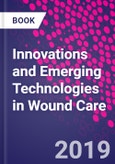Innovations and Emerging Technologies in Wound Care is a pivotal book on the prevention and management of chronic and non-healing wounds. The book clearly presents the research and evidence that should be considered when planning care interventions to improve health related outcomes for patients. New and emerging technologies are discussed and identified, along with tactics on how they can be integrated into clinical practice. This book offers readers a bridge between biomedical engineering and medicine, with an emphasis on technological innovations. It includes contributions from engineers, scientists, clinicians and industry professionals.
Users will find this resource to be a complete picture of the latest knowledge on the tolerance of human tissues to sustained mechanical and thermal loads that also provides a deeper understanding of the risk for onset and development of chronic wounds.
Please Note: This is an On Demand product, delivery may take up to 11 working days after payment has been received.
Table of Contents
Aetiology and pathogenesis of common wounds 1. Tissue changes with age, disease and chronic conditions 2. Pressure ulcers and diabetic foot ulcers 3. Venous, arterial and lymphedema wounds 4. Burns 5. Surgical and traumatic wounds 6. Wounds associated with prosthetic use 7. Infections in wounds
Bioengineering in diagnosis and prognosis 8. Sensors and systems for detecting tissue damage 9. Biomarkers in skin, sweat, blood and urine 10. Optical and imaging modalities for assessing potential tissue damage 11. Wound infection detection assays and technologies
Biomedical engineering approaches to prevention 12. Materials and designs of support and tissue-interfacing surfaces 13. Biomechanical engineering design of prophylactic dressings 14. Protecting tissues from medical device-related injuries 15.Computer-aided sensing and monitoring of tissue exposure to body loads 16. Electrical stimulation technologies to preserve tissue tolerance to loads 17. Biotechnology of nutritional supplements
Advanced treatments and clinical outcomes 18. Innovations in dressing materials and structures 19. New approaches to wound cleansing and debridement 20. Emerging negative pressure therapy technologies 21. Technologies for closure and repair of large wounds 22. Trends in compression therapies 23. Cell and tissue engineering approaches and related topical agents 24. Gene therapy and stem cell research relevant to wound healing
Authors
Amit Gefen Professor in Biomedical Engineering, Berman Chair in Vascular Bioengineering, Tel Aviv University, The Iby and Aladar Fleischman Faculty of Engineering, Tel Aviv University, Ramat Aviv, Israel.. Professor Amit Gefen received the B.Sc. in Mechanical Engineering and M.Sc. and Ph.D. in Biomedical Engineering from Tel Aviv University in 1994, 1997, and 2001, respectively. During 2002-2003 he was a post-doctoral fellow at the University of Pennsylvania, USA. He is currently a Full Professor with the Department of Biomedical Engineering at the Faculty of Engineering of Tel Aviv University and the Herbert J. Berman Chair in Vascular Bioengineering. Prof. Gefen has also been the Head of the Ela Kodesz Institute for Medical Engineering and Physical Sciences at Tel Aviv University. The research interests of Prof. Gefen are in studying normal and pathological effects of biomechanical factors on the structure and function of cells, tissues and organs, with emphasis on applications in chronic wound research. He is the Editor-in-Chief of Clinical Biomechanics (published by Elsevier), and has also edited several booksand several Special Issues in journals such as the Annals of Biomedical Engineering, Journal of Biomechanics, Computer Methods in Biomechanics and Biomedical Engineering and more. Recently, Prof. Gefen chaired the Etiology expert panel for development of the International Pressure Ulcer Prevention & Treatment Guidelines (2019) and also chaired the global panel of experts who developed the International Consensus Document for Device-related Pressure Ulcers, published by the Journal of Wound Care (2020).








